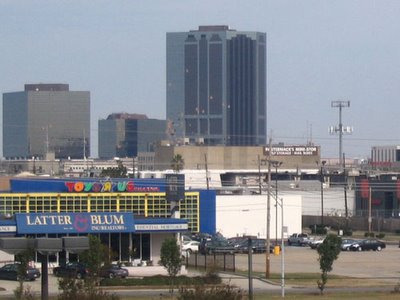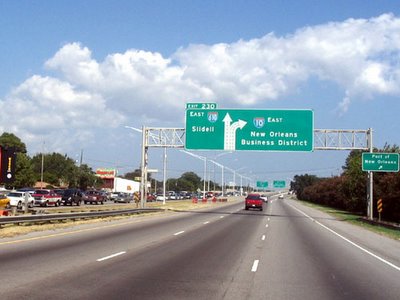This disaster did not have to happen. The magnitude of Katrina's impact is staggering and the effects will be felt locally and regionally for decades. Over 1,000 people reported dead in New Orleans, potentially a million people displaced, tens of thousands of structures in New Orleans damaged beyond repair, and now the economic losses are just starting to be realized. The Port of New Orleans is slow to recover, a record U.S. trade gap in September and the state of Louisiana is cutting vital programs to meet a $1 billion budget shortfall (soon to balloon with the required repayments to FEMA). Beyond the statistics remains the potential loss of a culture, damage to a historic jewel and a total disruption to a unique way of life. This all could have been prevented.
Most of us know the famous quote by George Santayana: "Those who cannot learn from history are doomed to repeat it". The focus of post-Katrina news coverage was on hurricane response. Although poorly planned and implemented, the lack of adequate hurricane response pales in comparison to the lack of planning to protect New Orleans from a predictable event. Since the early 1990s federally-funded research conducted by LSU and other academic institutions has predicted this event and its outcome. These studies have been presented to local, state and federal agencies responsible for flood protection in New Orleans. These studies have been presented to congressmen, and state elected officials for the past 15 years. In 2001 the Times-Picayune consolidated information from these studies, conducted in depth interviews and analyses and reported a series about the potential effects from this disaster. Dr. Ivor van Heerden, director of the LSU Hurricane Center has made accurate predictions of this disaster for many years (
http://hurricane.lsu.edu/_in_the_news/april21_advocate.htm). But the news media has made very little noise about this fact, and government officials have said very little about their involvement in this lack of planning.
This story gets worse. The 1927 Mississippi River flood is considered to be, until Hurricane Katrina, the single most devastating natural disaster to strike the U.S. The total number of dead from the 1927 flood is not known but it was likely in the thousands. Approximately 700,000 people were displaced by flooding of 27,000 square miles of land. The 1927 flood changed the political, demographic and economic landscape of the U.S. Herbert Hoover, then Secretary of Commerce, became famous for his lead in the relief efforts which led to his being elected to the office of the President in 1929. So who cares, right? That was 1927, not 2005 and cannot possibly be relevant to today's situation.
The failure of the levee system leading to the 1927 Mississippi River flood was a predictable event and had been predicted by numerous engineers. Those in power in government agencies and elected politicians refused to listen, the disaster was not avoided and the focus of the times following the disaster was on relief. Changes were eventually made to flood control measures on the Mississippi River, but only after a massive loss of life and near economic disaster for the U.S., none of which had to happen.
How about another watershed event for the U.S.? For years prior to September 11, 2001 the U.S. government was warned about the possibility of a terrorist attack on the U.S. The 9-11 Commission Report clearly outlines all of the opportunities that were provided to the U.S. government to thwart the attacks. Of course, the attacks happened, a tremendous loss of life was involved, it has completely change the way Americans live their lives, how govenment funding is appropriated and has led to wars in two distant countries.
Back to the present. These two simple past examples of our elected officials and government agencies not responding to predictable distrastous events in advance are analagous to pre-Katrina New Orleans. There are other similar examples in our history. Even FEMA recognized a hurricane making landfall on New Orleans as being the single greatest natural disaster facing the U.S. Yet nothing was done. Past history tells us that inaction toward predictable events leads to massive disasters. Yet nothing was done.
Over 1,000 dead in New Orleans, a million people displaced, tens to hundreds of billions of dollars in damage - all of which was totally preventable with simple actions taken in advance. Do our elected officials that ignored the warnings and the heads of government agencies that did not spend money appropriately, or worse, allowed for poor quality construction of existing facilities, have any civil or criminal culpability for these damages? History tells us they do not, that we will learn nothing from this disaster and not work towards preventing future disasters.
Now let us predict the future (it is easy to do with history as your guide). Some people will become famous for their response to the disaster, and many will deserve the accolades. New Orleans will become a shell of its glorious past. The State of Louisiana's economy may never recover. The U.S. economy will take a major short-term hit, but will rapidly recover as money is spent on disaster relief. Hundreds of thousands of people will permanently relocate to other urban areas across the U.S. leading to a large-scale demographic change in our population. And finally, because our society elects people to power for their ability to respond to disasters instead of their ability to guide and protect people from them, politicians will continue to ignore warnings by highly educated individuals about potential disasters that could cause a major loss of life, economic disruption and cultural collapse.
However, it is not too late to change this course of events. It is time for our news media and thinking individuals in the community to pose hard questions to our politicians and agency officials about their culpability in this disaster. Those who ignored the clearly-stated warnings need to be held responsible. And most importantly, our elected leaders need to plan for protection and take steps to manage predictable events instead of patting themselves on the back for responding to preventable disasters.






























